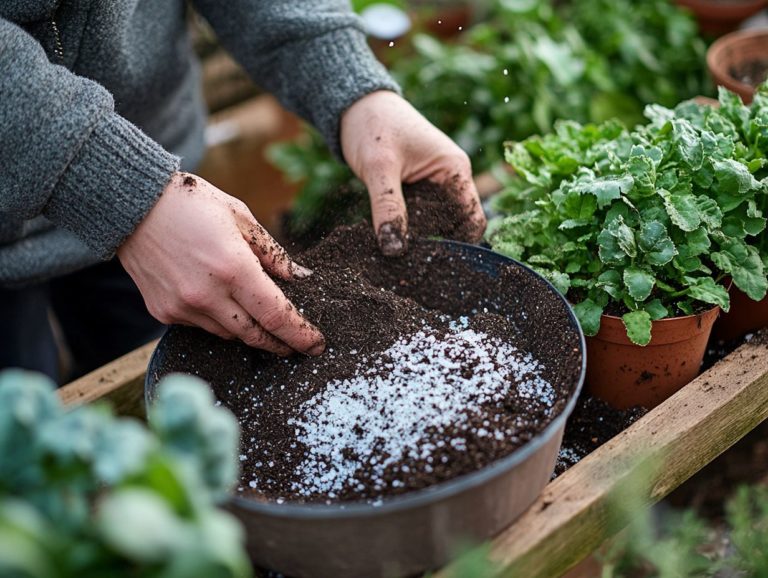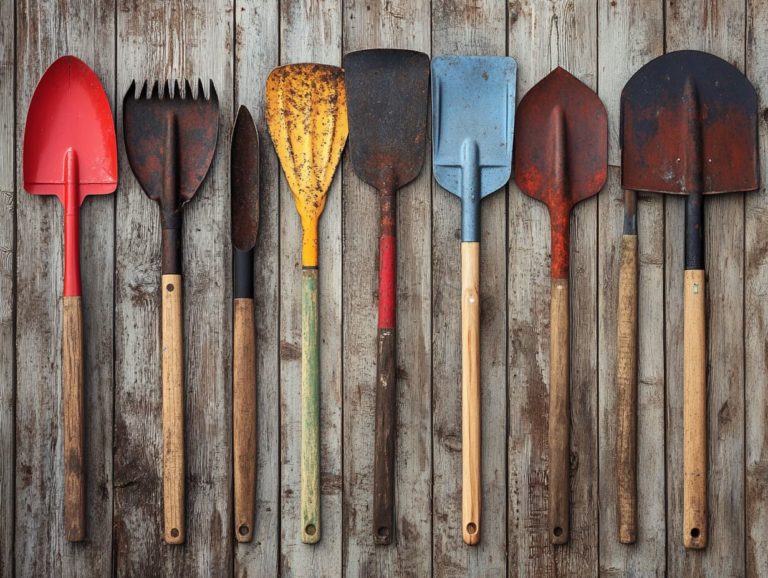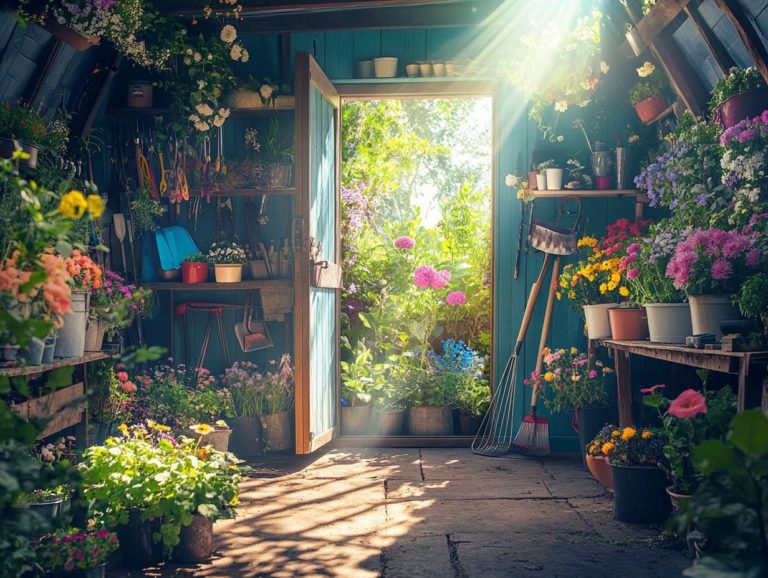Best Cold-Weather Garden Hose Solutions
As winter approaches, you face the challenge of protecting your tools and plants from the biting cold.
Choosing the right garden hose solutions can significantly impact your watering system’s functionality in frigid temperatures.
This article delves into innovative products and strategies, such as insulated and heated hoses, hose bib covers, and frost-free spigots, all designed to keep your garden thriving throughout the winter months.
Discover how to winterize your garden tools and safeguard your outdoor spaces, ensuring a vibrant and flourishing garden when spring arrives!
Contents
- Key Takeaways:
- 1. Insulated Garden Hoses
- 2. Heated Garden Hoses
- 3. Hose Reels with Covers
- 4. Hose Bib Covers
- 5. Frost-Free Spigots
- 6. Hose Splitters
- 7. Hose Nozzles with Adjustable Pressure
- 8. Hose Storage Options for Winter
- 9. Drip Irrigation Systems
- 10. Watering Cans for Precise Watering
- 11. Protecting Outdoor Faucets
- 12. Using a Timer for Watering
- 13. Mulching and Insulating Plants
- 14. Using a Rain Barrel
- 15. Winterizing Your Garden Hose
- Frequently Asked Questions
- What are the best cold-weather garden hose solutions?
- Are there any garden hoses specifically designed for cold weather?
- What type of hose material is best for cold weather?
- Can I use a regular garden hose in cold weather?
- Do I need to drain my garden hose during cold weather?
- What other precautions should I take when using a garden hose in cold weather?
Key Takeaways:
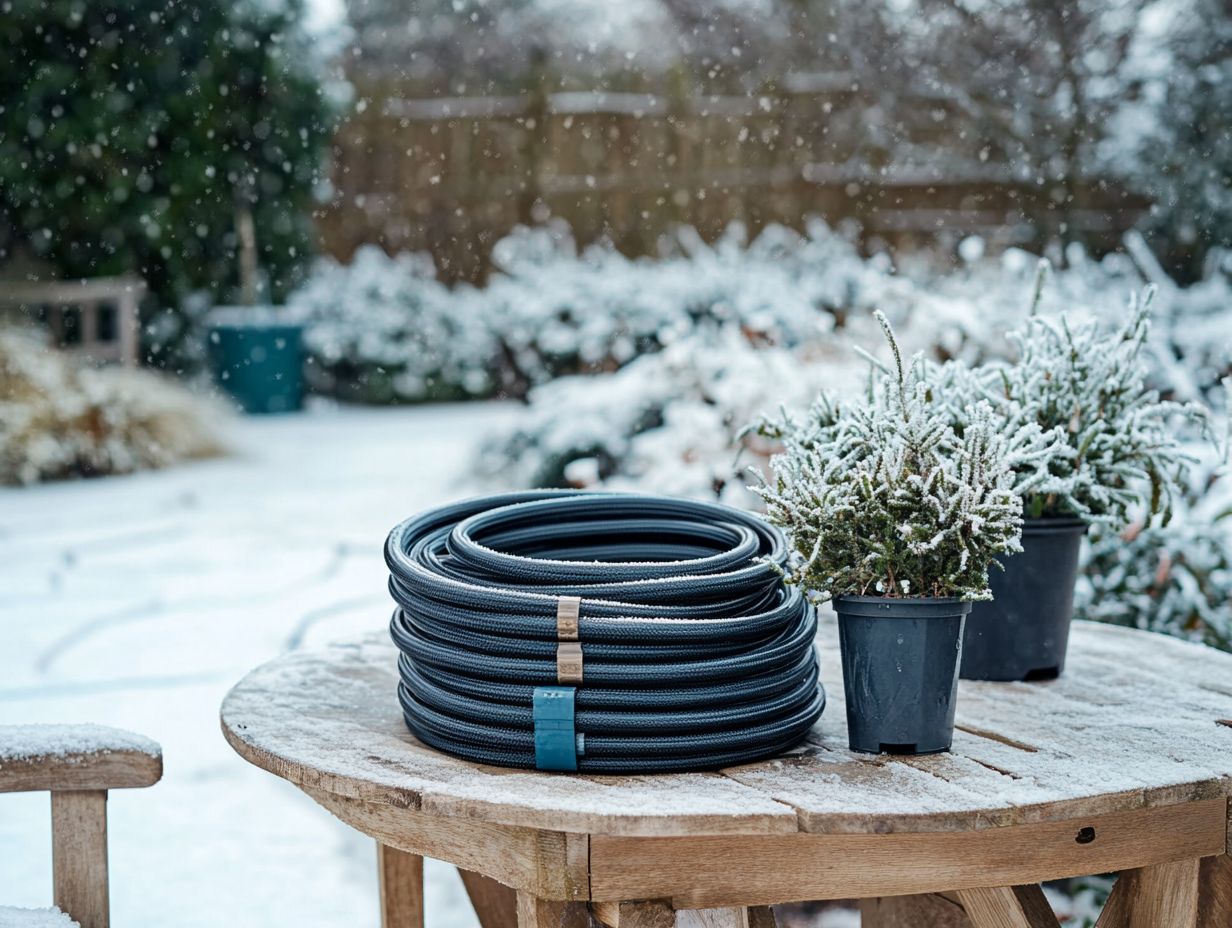
- Invest in an insulated garden hose to prevent freezing and ensure water flow during cold temperatures.
- Consider using a heated garden hose for extreme cold weather conditions to avoid damage and maintain water flow.
- Protect your garden hose by using a hose reel with a cover, hose bib covers, and frost-free spigots to prevent freezing and damage.
1. Insulated Garden Hoses
Insulated garden hoses are essential for maintaining your water supply and preventing freeze damage during winter, particularly in colder climates where temperatures can plunge to 32 degrees Fahrenheit or 0 degrees Celsius. These conditions can severely impact your outdoor plumbing and gardening endeavors.
Crafted from materials like rubber tubing, these hoses are designed to withstand harsh weather and provide longevity. They effectively retain the desired water temperature, ensuring your plants receive hydration without the shock of icy water.
Various insulation materials, such as foam or reflective surfaces, work to minimize heat loss. This makes them ideal for both scorching summers and frigid winters.
Choosing the right insulated hose is crucial for your specific gardening needs. Some gardens may demand hoses that offer greater flexibility for intricate layouts, while others might require enhanced durability for rugged terrains.
Notable brands like Flexzilla provide high-quality options that not only meet these diverse requirements but also prioritize ease of use and storage. They are a top choice for gardening enthusiasts.
2. Heated Garden Hoses
Heated garden hoses are designed to tackle the challenges that freezing temperatures present. With built-in heating wires, they maintain a steady flow of water, preventing kinking and freeze damage throughout the winter months.
These innovative hoses also ensure that your outdoor plumbing remains functional, even in the harshest conditions, providing you with an efficient solution for all your watering needs. Unlike traditional hoses that often become brittle or unusable in cold weather, heated options like those from Gilmour and Goodyear exhibit remarkable energy efficiency.
They consume less power while effectively thawing their contents, saving you money on energy costs and minimizing the risk of plumbing disasters. You ll appreciate the peace of mind that comes with having a reliable tool designed to withstand winter’s fury, allowing you to carry out seamless gardening and maintenance activities all season long.
3. Hose Reels with Covers
Hose reels with covers are essential for your effective hose maintenance and storage. They provide a protective way to manage your garden hose, ensuring it stays free from kinks and damage caused by the elements.
Using hose reels keeps your outdoor spaces organized and significantly extends the lifespan of your hoses. These innovative tools come in various styles, including wall-mounted, portable, and retractable options, each offering features tailored to meet your gardening needs.
For instance, brands like Flexzilla are celebrated for their lightweight yet durable reels that prevent tangling. In contrast, Briggs and Stratton provides models with added stability and easy access.
Choose a quality hose reel and watch your hoses stay neatly stored and ready for action! Investing in a quality hose reel means your hoses will be shielded from harsh weather conditions, making it a valuable addition to your gardening toolkit.
Don t let winter catch you off guard prepare now for a thriving garden come spring!
Visit your local store or browse online for the best winter garden hose options today!
4. Hose Bib Covers
Hose bib covers are essential for protecting your outdoor faucets from freeze damage during chilly weather. They serve as a barrier that insulates the faucet and keeps the water flowing when temperatures dip.
These covers come in various styles, from simple foam sleeves to more robust models made from insulated plastic or rubber. The choice of insulation material is crucial; it creates an air pocket that prevents the water inside the pipes from freezing.
Ensure these protective covers are installed before winter to reduce the risk of costly plumbing repairs. Brands like IEKA and Swan offer reliable options that deliver superior insulation and are designed for easy installation. These are must-haves for homeowners eager to protect their plumbing.
5. Frost-Free Spigots
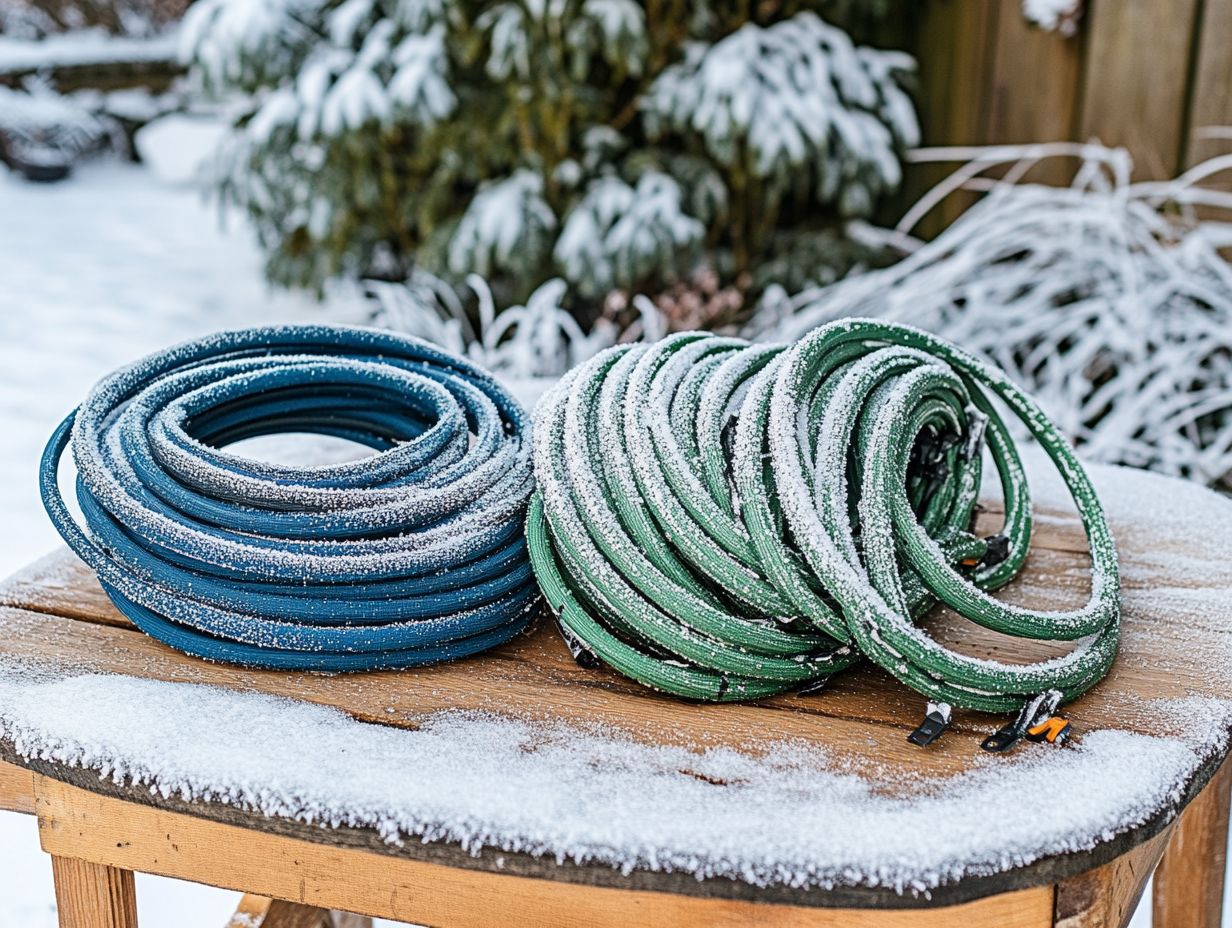
Frost-free spigots prevent freeze damage, ensuring a reliable water supply during those chilly months. With these fixtures, you can use your outdoor faucets without worrying about pipe bursts or plumbing nightmares.
What sets these valves apart is their unique design. They shut off the water supply inside your home rather than at the exposed faucet, providing extra protection when temperatures drop. While conventional outdoor faucets may freeze and lead to maintenance hassles, these alternatives grant you peace of mind.
Install your frost-free spigot today for peace of mind all winter! Ensuring the spigot slopes downward allows any residual water to drain, preventing ice formation. Trusted brands like Woodford and BBQGuys offer frost-free options that outshine traditional fixtures in durability and efficiency.
6. Hose Splitters
Hose splitters provide a solution for getting the most from one outdoor faucet. They let you manage multiple watering tasks efficiently, enhancing your irrigation system.
These devices connect two or more hoses, allowing simultaneous watering of different areas without the hassle of switching lines. This feature is particularly useful for those with expansive gardens or potted plants needing varying amounts of water.
Installation is typically easy, requiring only minimal tools. They are designed to fit standard faucets with ease. Brands like Giraffe Tools and Stanley Fatmax provide durable options built to endure outdoor conditions while ensuring reliable performance.
The benefits of hose splitters extend beyond convenience; they also promote more effective water usage and contribute to better plant health, making them essential for your gardening toolkit.
7. Hose Nozzles with Adjustable Pressure
Hose nozzles with adjustable pressure empower you to customize water flow for your gardening needs. Whether you want a gentle mist for delicate blooms or a robust stream for demanding tasks, these nozzles enhance water management and can help reduce energy bills.
You ll find various nozzle types, from fan sprays that cover larger areas to pinpoint jets perfect for focused watering. Brands like Gilmour and Orbit provide high-quality options built to last and promote efficient water use.
Most nozzles feature settings for easy switching between different spray patterns. This versatility allows for effective watering of flower beds, vegetable gardens, or even washing your car. It s crucial to consider the pressure tolerance of these nozzles. High-quality models maintain consistent performance, ensuring steady water delivery despite pressure fluctuations in your garden hose.
8. Hose Storage Options for Winter
Properly storing your hoses for winter is essential. Options like garden hose reels and retractable hoses can prevent kinking and extend the lifespan of your hoses. They also protect them from freeze damage.
Investing a little time now to prepare your hoses for the colder months can save you both time and money down the line. Start by giving your hoses a thorough clean to eliminate dirt, debris, and any leftover fertilizers that could cause long-term damage.
Once they’re clean, consider investing in high-quality storage solutions from trusted brands like Zero-G and H2O Works. For indoor storage, a wall-mounted hose reel keeps your hoses organized and out of sight. For outdoor options, use protective covers or storage sheds to shield your hoses from harsh winter elements.
By following these best practices, you ll ensure your garden hoses are in prime condition and ready to thrive in the next growing season.
9. Drip Irrigation Systems
Drip irrigation systems provide an efficient watering solution that conserves water and delivers moisture directly to the root zones of your plants. This ensures their healthy growth and health.
These systems include components like drip emitters, tubing, filters, and pressure regulators. They work together to provide your plants with exactly what they need. In colder climates, their adaptability is impressive, allowing for deep watering without over-saturating the surface, which can prevent frost damage.
Installing a drip irrigation system is simple and requires just a few straightforward steps:
- Lay out the tubing along the desired plant rows.
- Cut it to the appropriate size.
- Secure emitters at the right intervals.
Brands like Rain Bird, Hunter, and Netafim offer high-quality products, making it easier to implement and maintain effective watering practices in your garden.
10. Watering Cans for Precise Watering
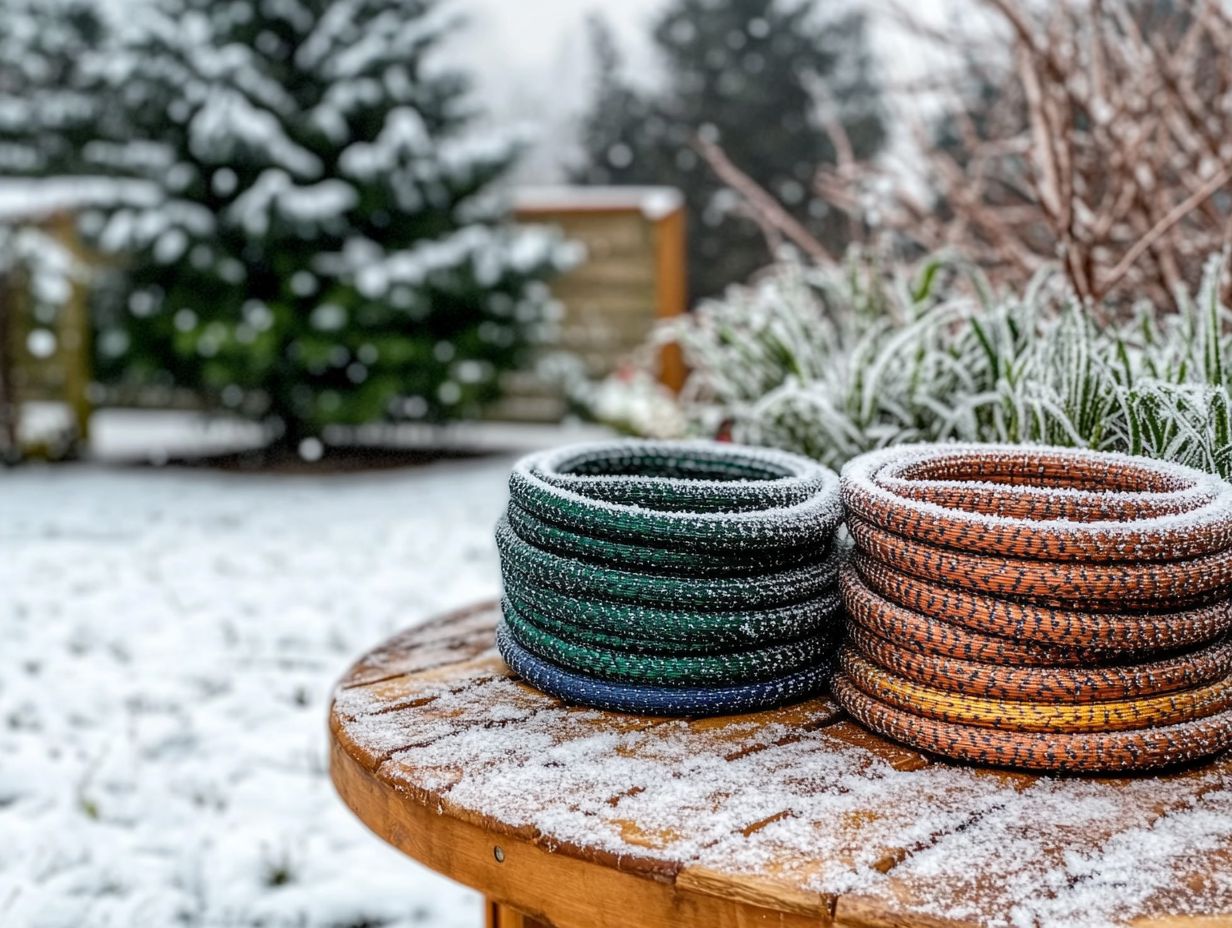
Watering cans designed for precision are essential tools for any gardener. They allow you to deliver just the right amount of water to specific plants, eliminating the risk of overwatering or harming delicate foliage.
These cans come in various styles and materials, each tailored to different needs. A classic metal watering can offers durability and adds timeless charm to your garden space.
In contrast, lightweight plastic cans are easy to handle, perfect for container gardening or tending to smaller plants. Some models feature a detachable spout for easy switching between a fine spray for fragile seedlings and a robust stream for more established plants.
When paired with other essential gardening tools, like trowels and pruners, a well-chosen watering can enhances your gardening experience. Choosing the right watering can based on your plants’ size and type is vital for optimal care and promotes healthier growth, ensuring your plants thrive in freezing temperatures.
11. Protecting Outdoor Faucets
Protecting your outdoor faucets from freeze damage is crucial for maintaining a reliable water supply during chilly months. Use effective insulation materials to shield them from harsh elements.
Consider investing in faucet covers, made from thick, weather-resistant foam or other insulating materials, to provide extra protection. These covers easily slip on and off for convenience.
Also, explore specialized insulation options like pipe sleeves or heat tape for exposed piping. These will offer additional defense against freezing. Ignoring these fixtures can lead to burst pipes, costly repairs, and potential water damage inside your home.
Taking simple preventative steps, such as winterizing your plumbing systems or draining outdoor faucets, including the hose bib, before the freeze sets in, can save you from unexpected plumbing headaches.
12. Using a Timer for Watering
Using a watering timer is a savvy choice for automating your garden irrigation system, ensuring efficient watering while reducing the hassle of constant hose management. This is especially helpful in winter.
By incorporating a watering timer into your gardening routine, you can reclaim precious time and make significant strides in water conservation. These devices grant you exact control over the amount and timing of water distribution, simplifying the maintenance of healthy landscapes, regardless of the weather.
You’ll find a variety of timers available, from straightforward mechanical models to cutting-edge smart timers that connect to weather forecasts, helping optimize your watering schedule. Brands like Rain Bird and Orbit present reliable options tailored to a range of gardening needs. Whether you re tending to a cozy backyard garden or overseeing a sprawling agricultural setup, you can make irrigation both effective and environmentally friendly.
13. Mulching and Insulating Plants
Mulching and insulating your plants are exceptional strategies for shielding your garden against the harsh realities of cold weather. These methods help regulate soil temperature and retain moisture both vital for your plants’ health throughout winter.
Not only do these techniques protect against frost, but they also enhance overall soil quality and curtail weed growth. Common types of mulch include organic options like straw, wood chips, and shredded leaves. These break down over time to enrich the soil. In contrast, inorganic mulches like landscape fabric or gravel offer a durable solution that requires minimal upkeep.
Insulation materials like burlap or frost blankets provide that extra layer of protection, safeguarding delicate plants from extreme temperatures. For the best results, apply a layer of mulch at least two to four inches thick. Make sure it’s evenly spread and kept away from plant stems.
Adopting these practices fosters a healthier garden ecosystem, leading to stronger plants and improved yields year after year.
14. Using a Rain Barrel
Imagine effortlessly collecting rainwater with a rain barrel it’s eco-friendly and incredibly efficient for your gardening needs. This method allows for effective watering while reducing your reliance on traditional water sources and minimizing excessive water use.
These systems do more than just manage rainwater sustainably; they play a vital role in your irrigation setup. By storing rainwater, you can ensure your plants receive the hydration they need during dry spells, all without tapping into municipal water sources. This fosters a healthier garden and significantly reduces your water bills, making it a financially smart choice.
Embracing rain barrels can also ease the burden on local stormwater systems. Don’t miss out on the chance to save water install a rain barrel today! This contributes to a more resilient urban environment while conserving this precious resource.
15. Winterizing Your Garden Hose
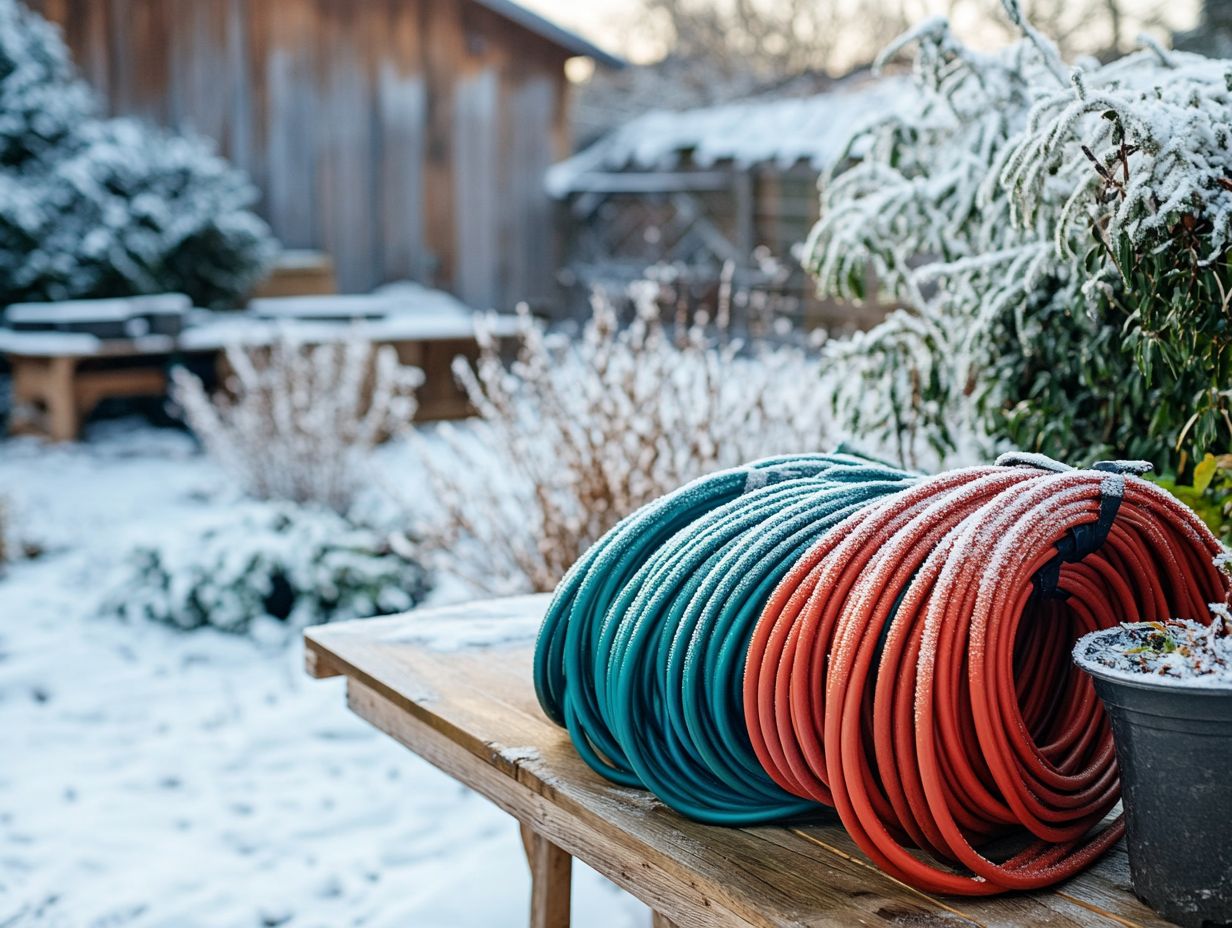
Winterizing your garden hose is essential to prevent freeze damage and ensure it stays in prime condition for the next gardening season. This involves a series of steps designed to protect the hose and its fittings from harsh winter elements.
-
Start by draining all the water from the hose. Hold it at a slight incline and use the nozzle to release any remaining moisture. This simple step can save you a lot of trouble later.
-
Next, pay attention to how you coil the hose. Proper coiling is vital; avoid sharp bends that could lead to kinks or fractures over time. Treat your hose well, and it will reward you with longevity.
-
For storage, choose a cool, dry place ideally indoors away from extreme temperatures to enhance hose storage.
-
Consider investing in products like Freeze Miser, which can provide extra protection by automatically draining any trapped water. Insulated covers can also offer additional defense against the cold.
Don t forget: Regular maintenance checks throughout the gardening season not only prolong the life of your hoses but also enhance their overall performance. Taking these steps ensures your gardening tools are ready when the season returns!
Frequently Asked Questions
What are the best cold-weather garden hose solutions?
The best solutions include heated hoses, insulated hoses, and hoses that don t crack in cold temperatures.
Are there any garden hoses specifically designed for cold weather?
Yes! Many garden hoses on the market are designed for cold weather, featuring insulation and freeze resistance to prevent damage.
What type of hose material is best for cold weather?
Hoses made from materials like polyurethane, rubber tubing, or vinyl are better for cold weather, as they are more flexible and less likely to crack.
Can I use a regular garden hose in cold weather?
It’s not recommended to use a regular garden hose in cold weather, as it can easily freeze and crack. Invest in a hose designed for cold weather conditions instead.
Do I need to drain my garden hose during cold weather?
Always drain your garden hose after each use during cold weather to prevent any leftover water from freezing and damaging the hose.
What other precautions should I take when using a garden hose in cold weather?
Protect the hose from extreme temperatures, use a insulated hose, and be sure to disconnect and drain it after each use to prevent damage.
Act now to protect your investments before the cold hits!

